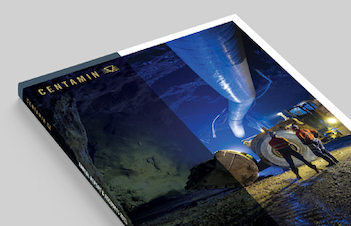Gold mining creates a significant amount of tailings waste as mined ore is crushed, milled and processed to separate the gold from the ore.
This process involves hazardous chemicals and reagents such as cyanide and flotation chemicals, of which residual quantities remain in the tailings after processing. These tailings form the bulk of Centamin’s hazardous waste and are pumped into a specially designed and engineered earth-filled lined impoundment known as a tailings storage facility (“TSF”). TSFs need to be carefully managed and monitored to ensure the stability of the embankment walls and to prevent seepage of possible contaminants into the local environment.
As a responsible mining company, Centamin is committed to the Global Industry Standard on Tailings Management (“GISTM”) with the objective to cause no harm to people or the environment through tailings facility design, operation and closure. In August 2023, we completed a gap analysis against the standard and have drafted a clear roadmap for full conformance by 2025.
TAILINGS GOVERNANCE
We employ a robust tailings governance approach based on good industry practice, risk management review and assurance. Operating manuals are in place for our tailings storage facilities which detail the operation, monitoring, maintenance, construction, closure and rehabilitation guidelines for the facility. The manuals define responsibility of key personnel and a Trigger Action Response Plan to effectively assess deviations from standard operating practice and required actions, including what to do in the event of an incident or emergency.
TSFs are monitored through a layered assurance system comprising internal operational specialists, a formally appointed external Engineer of Record (“EoR”), our Accountable Executive and an Independent Technical Reviewer; and with mechanisms in place for reporting risk and tracking mitigation measures. Through quarterly site visits, the EoR is empowered to conduct routine performance and safety reviews of Sukari’s Tailings Management System.
The Accountable Executive has ultimate accountability for the safe management of our tailings facilities and oversees the development and implementation of the tailings management system including emergency preparedness and response and recovery in the event of failure. The Accountable Executive is supported in his role by an Independent Technical Reviewer and the Board of Directors.
At Sukari, tailings management is defined as a critical risk and, as such, standards are in place that define the minimum requirements for the management of tailings to protect human health and the environment through facility design, construction, operation and closure. The Critical Risk Standard also covers incident and emergency response, management of change processes, performance reviews and independent audits.
We publish an annual tailings management report, the content and format of which is aligned to Principle 15 of the GISTM.
Tailings Management Disclosure
REVIEW AND ASSURANCE
To ensure facilities are performing as designed, we have several programmes for inspecting, auditing and reporting on the safety of our tailings facilities.
Operation of the TSFs is managed by a dedicated team of people who conduct daily performance monitoring including visual inspections to confirm operational and structural integrity. The EoR participates in weekly operational performance reviews and performs quarterly dam safety inspections. Quarterly meetings are held by the Accountable Executive with the involvement of the EoR and all safety critical roles to discuss operational performance. Tailings management is also a standing agenda item for the Sustainability Committee of the Board.
In 2023, we engaged a third party to complete a Failure Modes and Effects Analysis (“FMEA”) and to update the risk assessment for the tailings facilities. Probable failure modes were evaluated for a combination of normal operating conditions and flood conditions; and risk mitigation measures identified.
The most recent independent Dam Safety Review of our TSFs was performed in 2021, against the applicable design standards and the GISTM.

